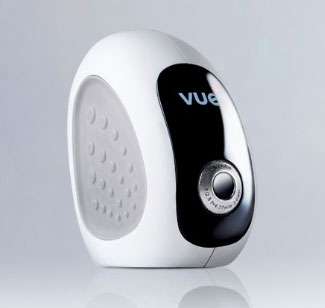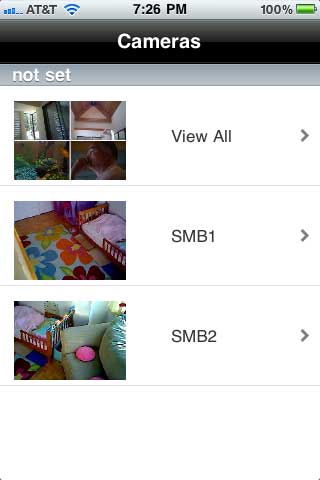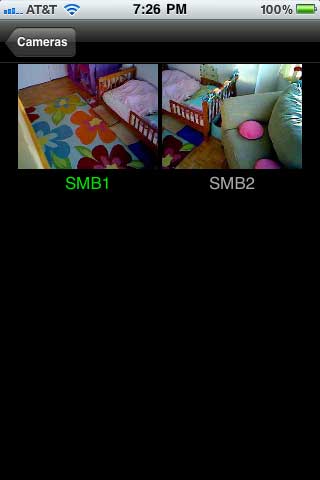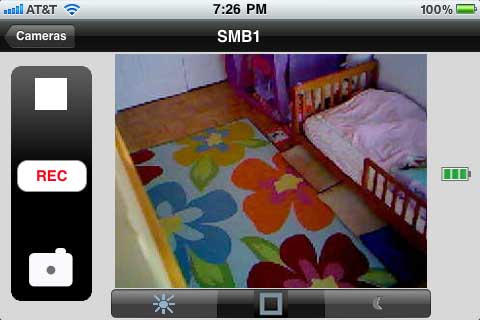The VueZone iPhone App—Don’t Use it to Spy on Your Children
While trying out the VueZone iPhone app, I consider the ethics of having my two-and-a-half year-old daughter under surveillance.
By Daniel A. Begun
A number of months ago I was watching one of the final episodes of 24. (I was never really much of a 24 fan, but I started watching it during the final season because Battlestar Galactica babe, Katee Sackhoff, was in it). There was an interrogation scene, where for a few brief seconds, I could have sworn I saw something sitting on the table that looked very familiar. That familiar-looking item was a Vue camera from the very same Vue Personal Video Network Wireless Camera System that I looked at last October.
In case you haven’t read my previous blog about the Vue: The Vue is a wireless camera system that connects to your home network and sends live streaming video to a cloud-based server for live monitoring, recording, and playback, over the Internet As to what Jack Bauer and company were doing with such a decidedly consumer-centric product in their state-of-the-art facility is another matter. TV shows and movies often veer away from reality for the sake of dramatic license. For instance, I was watching a movie (It’s Complicated) the other night that takes place in Santa Barbara. In one scene it was raining cats and dogs. I’m sorry, but I lived in Santa Barbara for five years, and I never saw it rain like that.
As to what Jack Bauer and company were doing with such a decidedly consumer-centric product in their state-of-the-art facility is another matter. TV shows and movies often veer away from reality for the sake of dramatic license. For instance, I was watching a movie (It’s Complicated) the other night that takes place in Santa Barbara. In one scene it was raining cats and dogs. I’m sorry, but I lived in Santa Barbara for five years, and I never saw it rain like that.
So when I spied the Vue camera on TV, it got me to thinking. When I first looked at the product, one of the things I wished I could do was view the camera feeds remotely from my iPhone. Avaak (the Vue's manufacturer) promised an iPhone client sometime in the future, but it didn’t materialize in the time frame I was evaluating it. The iPhone client had since come out, however; so I thought it would be interesting to do a follow up and play around with the iPhone app—especially since I had considered it an essential missing ingredient of the device’s capabilities. I also had an ulterior motive as well:
My two-and-a-half year-old daughter has reached that developmental stage where she can now play by herself for long periods of time. She often plays in her room and it is wonderful hearing all the things she says as she plays with her toys and “reads” her books. But, similar to the pitfalls of physics’ “observer effect,” if she knows she’s being watched, she’ll act differently—in this case, most likely wanting me to play with her. (For those geeks who actually know what the “observer effect” is, I’m not implying that watching my daughter is necessarily directly related to quantum physics—I was merely trying to find an appropriate analogy, without having to invoke the macabre Schrödinger's cat thought experiment. Oops, too late.) So I thought if I put a Vue camera or two in her room, I could see what’s she’s doing without her knowing she was being watched. As soon as the Vue system arrived in my home (for the second time), I wasted no time in setting up both cameras that the Vue system comes with, in my daughter’s room. Unfortunately, the Vue cameras have a very limited field of view, and simply can’t cover a lot of area in cramped spaces. Even with both cameras set up and positioned carefully, I still couldn’t get full coverage of her room. I had also forgotten just how strong the glue was in the peel-and-stick tape for the camera mounts. Needless to say, I took a few layers of paint off when I later removed the mounts. Note to self: buy Spackle and white paint.
As soon as the Vue system arrived in my home (for the second time), I wasted no time in setting up both cameras that the Vue system comes with, in my daughter’s room. Unfortunately, the Vue cameras have a very limited field of view, and simply can’t cover a lot of area in cramped spaces. Even with both cameras set up and positioned carefully, I still couldn’t get full coverage of her room. I had also forgotten just how strong the glue was in the peel-and-stick tape for the camera mounts. Needless to say, I took a few layers of paint off when I later removed the mounts. Note to self: buy Spackle and white paint.
Before I installed the iPhone app, I reacquainted myself with the product and its Internet-based interface. Not much had changed since I looked at it last fall. In addition to the introduction of the iPhone app, the only other significant change I could detect was that the ability to schedule recordings had been added. I ran into a number of issues with the scheduling utility and it often didn’t record when I thought it was supposed to. But scheduling recordings wasn’t my main point of focus.
I downloaded the free VueZone app to my iPhone. (The VueZone Website states that Android and Blackberry apps are “coming soon.”) . When you launch the VueZone iPhone app, you have to supply your VueZone UserID and password. Once you log in, it shows a simple-looking screen that shows options for viewing your two cameras individually or for viewing all the cameras at once. If you have additional cameras set up, or if another Vue user grants you access to his cameras, then they would also show up as additional cameras. The listings for my two cameras displayed thumbnails that showed static images from the last time I viewed the cameras using the iPhone app. The View All listing uses a thumbnail that shows four different views from someone else’s home; I thought for a moment that I was going to get a voyeuristic view into someone else’s house! Perhaps I would be lucky enough and it would be Katee Sackhoff’s! But it was not to be. The View All thumbnail is just a generic image that never changes. Sigh...
When you click on the View All button, you see two small images of what the two cameras are currently seeing. In this mode, you are not actually watching live video; instead the app shows you a static image of what the cameras see, and switches back and forth between the two live feeds about once every second. Whichever is the most recently updated feed is highlighted in green. If you want to see live streaming video, however, you do that by viewing the feed of just that one camera by selecting it from the main screen. When you select a camera to watch, it shows you a live feed of what the camera sees. The resolution isn’t that great and the frame rate leaves much to be desired—but hey, it’s a live video going from your Vue camera to your iPhone (or iPad or iPod touch) over the Internet--not too shabby in terms of technological capabilities! The screen includes a few other items as well. To the right is a small battery icon that displays the approximate charge left in the camera’s battery (Avaak claims a camera’s battery should last about a year with typical usage—the camera only operates at full power when it is being actively viewed or when it's recording). At the bottom of the screen are options for increasing or decreasing the brightness of the image. At bedtime, when lights are out in my daughter’s room, the camera just shows pitch black, regardless of the brightness setting. Unless I were to use an infrared camera, I’d see the same dark results with virtually any camera.
When you select a camera to watch, it shows you a live feed of what the camera sees. The resolution isn’t that great and the frame rate leaves much to be desired—but hey, it’s a live video going from your Vue camera to your iPhone (or iPad or iPod touch) over the Internet--not too shabby in terms of technological capabilities! The screen includes a few other items as well. To the right is a small battery icon that displays the approximate charge left in the camera’s battery (Avaak claims a camera’s battery should last about a year with typical usage—the camera only operates at full power when it is being actively viewed or when it's recording). At the bottom of the screen are options for increasing or decreasing the brightness of the image. At bedtime, when lights are out in my daughter’s room, the camera just shows pitch black, regardless of the brightness setting. Unless I were to use an infrared camera, I’d see the same dark results with virtually any camera.
To the left of the live video-feed image are three buttons. The top one is a play/stop button, the middle one is a video-record button, and the bottom one is a snapshot button. When you press the record button to record the video, the record button flashes to indicate it is recording. Press the stop button to stop recording. When you stop recording, however, the live video feed to the iPhone stops as well. To resume watching live video you have to press the play button. A number of times I ran into an issue where once I stopped a live feed, I couldn’t resume watching it again unless I actually quit out of the application and started it over again. Pressing the snapshot button captures a static image. Any video you record or photos you snap are saved to the Vue server. Unfortunately, you cannot access recorded video or captured images using the iPhone app. The only way to view captured video and static images is to login to the VueZone Website from a computer’s browser that supports Flash.
For my purposes I didn’t really need the recording feature; I just wanted to be able to pick up my iPhone to quickly get a gander at what my daughter was up to. While it worked, it didn’t do what I wanted it to very well. Since the field of view was so limited, there were times she was out of view of both cameras. Also, due to the limited resolution, it was often difficult to make just what she was playing with or what she was reading. But perhaps most importantly, I found that the more I used it to “spy” on my daughter, the more I started to get a nagging feeling in the back of my mind that I shouldn’t be doing what I was doing.
Yes, she’s only two-and-a-half, and as such, it’s my duty as her father to keep a close eye on her to help keep her from getting in harm’s way. But in normal instances, she’s at least aware that I’m watching her—simply because we’re in the same room together and she can see me. It became increasingly obvious to me that I had my daughter under surveillance. Was this the example I really wanted to set for her? Is it possible for a parent to actually encroach on the privacy of a two-and-a-half year old? After only a few days of this, I removed the cameras from her room. Regardless of her age, it just wasn’t fair to her for me to be watching her without her knowledge.
The VueZone Website offers a number of potential uses for the Vue, and the very first example is “What are the kids up to right now?” Been there, done that, and no thank you. The second example is “Keep close tabs on your tabby.” I have a cat... A 17-year old cat. I could have one of the cameras focused on the basket she likes to sleep in. And if I did that, I don’t think I’d ever see the image change. She sleeps a lot. If she was a more active cat, I I’d be hard pressed to figure out where to put a camera that had a chance of actually seeing her for more than a fleeting second. Too bad the Vue doesn’t support motion detection.
The third example is “Keep an eye on those you love.” This one actually makes a lot of sense to me. If you want to make sure that elderly or disabled family members are okay, you could use the Vue to provide a quick visual peace of mind. But if you do this, I feel it is important that the people who’s homes you’re putting the cameras in are fully aware that there is a video camera recording them and that they know exactly where the cameras are pointing. I’d even go so far as to say that any visitor coming into their home should also be made aware of the cameras. I can just see the home health aide bristling at the sign on the front door of the septuagenarian’s home she’s about to visit, which says “Anyone entering this home is under video surveillance.” Perhaps there is a better way to word that. The problem is, the Vue camera transmits its signal back to a base station that attaches to a router or broadband modem—so Grandma’s house better have broadband Internet if you want to see what’s she’s up to with a Vue camera.
The next example shows that you can make sure that no one else is hanging out in your vacation home when you are not there. This is also a good idea, but it means that you’re vacation home also better have a broadband Internet connection that stays on when you are not there. The next example after that shows that you can use the Vue to let people virtually attend a party. Isn’t that what iChat and Skype are for? The final example is actually just a variation of a previous example: take a remote vacation by visiting your second home with the Vue. You can see the leaves turn color, the sun rise, the grass grow, the mail pile up, or the wasps come and go from the new nest above the front door.
So maybe Jack Bauer and company had it right all along…Use the Vue to stream live video (but no audio) from a very important interrogation. Okay, maybe not. At least, one interesting recent use of the Vue was to create a time-lapse video from the installation of the Toulouse-Lautrec exhibit at The San Diego Museum of Art, which you can see here.
I still stick to my original opinion that the Vue is very much a 1.0 product in desperate need of a makeover. And as it just so happens, an Avaak spokesperson told me “a new version of the Vue will be coming in Fall 2010.” I don’t have any details on what the new version will be like, but I was told by a different spokesperson that many of the changes in the new version are based on feedback that the company got from its user base. Let’s hope that is actually true and not just marketing speak.


